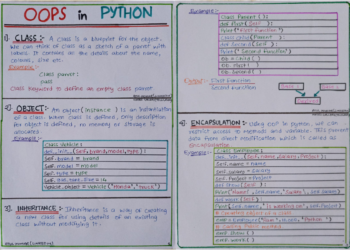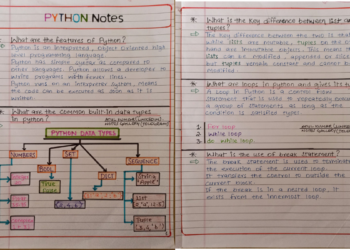Python String split() method splits a string into a list of strings after breaking the given string by the specified separator.
Example:
Python

Output

Python String split() Method Syntax

Parameters
- separator: This is a delimiter. The string splits at this specified separator. If is not provided then any white space is a separator.
- maxsplit: It is a number, that tells us to split the string into a maximum of the provided number of times. If it is not provided then the default is -1 which means there is no limit.
Returns
Returns a list of strings after breaking the given string by the specified separator.
What is the list split() Method?
split() function operates on Python strings, by splitting a string into a list of strings. It is a built-in function in Python programming language.
Python String split()
Python String split() method splits a string into a list of strings after breaking the given string by the specified separator.
Example:string = "one,two,three" words = string.split(',') print(words)
Output
[‘one’, ‘two’, ‘three’]
Python String split() Method Syntax
Syntax: str.split(separator, maxsplit)
Parameters
- separator: This is a delimiter. The string splits at this specified separator. If is not provided then any white space is a separator.
- maxsplit: It is a number, that tells us to split the string into a maximum of the provided number of times. If it is not provided then the default is -1 which means there is no limit.
Returns
Returns a list of strings after breaking the given string by the specified separator.
What is the list split() Method?
split() function operates on Python strings, by splitting a string into a list of strings. It is a built-in function in Python programming language.
It breaks the string by a given separator. Whitespace is the default separator if any separator is not given.
How to use list split() method in Python?
Using the list split() method is very easy, just call the split() function with a string object and pass the separator as a parameter. Here we are using the Python String split() function to split different Strings into a list, separated by different characters in each case.
Example: In the above code, we have defined the variable ‘text’ with the string ‘geeks for geeks’ then we called the split() method for ‘text’ with no parameters which split the string with each occurrence of whitespace.
Python

Similarly, after that, we applied split() method on different strings with different delimiters as parameters based on which strings are split as seen in the output.
Output

Time Complexity: O(n)
Auxiliary Space: O(n)
How does split() work when maxsplit is specified?
The maxsplit parameter is used to control how many splits to return after the string is parsed. Even if there are multiple splits possible, it’ll only do maximum that number of splits as defined by the maxsplit parameter.
Example:
In the above code, we used the split() method with different values of maxsplit. We give maxsplit value as 0 which means no splitting will occur.
Python

The value of maxsplit 4 means the string is split at each occurrence of the delimiter, up to a maximum of 4 splits. And last maxsplit 1 means the string is split only at the first occurrence of the delimiter and the resulting lists have 1, 4, and 2 elements respectively.
Output

Time Complexity: O(n)
Auxiliary Space: O(n)
How to Parse a String in Python using the split() Method?
In Python, parsing strings is a common task when working with text data. String parsing involves splitting a string into smaller segments based on a specific delimiter or pattern. This can be easily done by using a split() method in Python.
Python

Explanation: In the above code, we have defined a string ‘text’ that contains a sentence. By calling the split() method without providing a separator, the string is split into a list of substrings, with each word becoming an element of the list.
Output

Hope this tutorial on the string split() method helped you understand the concept of string splitting. split() method in Python has various applications like string parsing, string extraction, and many more. “How to split in Python?” is a very important question for Python job interviews and with this tutorial we have answered the question for you.
Check More: String Methods
Python String split() – FAQs
What does split('\t') do in Python?
In Python, the split('\t') method splits a string into a list of substrings based on the tab (\t) delimiter. Here’s how it works:

In this example, the split('\t') method divides the string text wherever it encounters a tab character (\t) and returns a list containing the separated substrings.
What is input().split() in Python?
input() is a built-in function in Python that reads a line from input, which is typically from the user via the console. split() is a method that splits a string into a list of substrings based on whitespace by default, or a specified delimiter. Together, input().split() allows you to read user input and split it into individual components based on whitespace.
Example:

Here, input() reads the input from the user, and split() divides the input into a list of words based on whitespace.
How to split a number in Python?
To split a number (typically an integer or float) into its individual digits, you can convert the number to a string and then split the string. Here’s an example:

In this example, str(number) converts the integer 12345 into a string, and list() converts the string into a list of individual characters (‘1’, ‘2’, ‘3’, ‘4’, ‘5’).
How to split a string into lines using the split() method?
To split a multi-line string into individual lines using the split() method, you can specify the newline character (\n) as the delimiter. Here’s an example:

In this example, split('\n') splits the multiline_text string wherever it encounters a newline character (\n) and returns a list of lines.
How to split a string number?
If by “split a string number” you mean splitting a string representation of a number into its individual characters or parts, you can use the split() method with an empty string as the delimiter. Here’s an example:

In this example, list(number_str) converts the string "12345" into a list of individual characters (‘1’, ‘2’, ‘3’, ‘4’, ‘5’).










